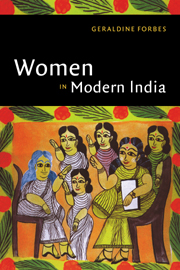Book contents
- Frontmatter
- Introduction
- 1 Reform in the nineteenth century: efforts to modernize women's roles
- 2 Education for women
- 3 The emergence of women's organizations
- 4 The movement for women's rights
- 5 Women in the nationalist movement
- 6 Women's work in colonial India
- 7 A time of transition
- 8 Women in independent India
- Bibliographic essay
- Index
- THE NEW CAMBRIDGE HISTORY OF INDIA
- References
Introduction
Published online by Cambridge University Press: 28 March 2008
- Frontmatter
- Introduction
- 1 Reform in the nineteenth century: efforts to modernize women's roles
- 2 Education for women
- 3 The emergence of women's organizations
- 4 The movement for women's rights
- 5 Women in the nationalist movement
- 6 Women's work in colonial India
- 7 A time of transition
- 8 Women in independent India
- Bibliographic essay
- Index
- THE NEW CAMBRIDGE HISTORY OF INDIA
- References
Summary
The first historical accounts of Indian women date from the nineteenth century and are a product of the colonial experience. These accounts tell of an ancient time when women were held in high esteem followed by a long period when their status declined. Then Europeans came on the scene. The foreign rulers, according to these narratives, introduced new ideas about women's roles and capabilities and these ideas were adopted by enlightened Indians. Until recently the history of women in British India has been recounted in this way, that is, as a slow but progressive march towards ‘modernity’ following a long period of stagnation and decline. Both British missionaries and those Indian reformers who welcomed the opportunity to put forth a critique of their own society hypothesized a ‘golden age’ followed by centuries of corruption and betrayal. Salvation came in the guise of European forms of governing, technology, and values. This way of writing about the past, particularly as linear movement through time toward a specific goal, was a hallmark of European history.
Both European-inspired histories and the Indian texts they cited shared a belief in a unique female nature. Indian texts essentialized women as devoted and self-sacrificing, yet occasionally rebellious and dangerous. Texts on religion, law, politics, and education carried different pronouncements for men depending on caste, class, age, and religious sect. In contrast, women's differences were overshadowed by their biological characteristics and the subordinate, supportive roles they were destined to play. Historians were equally essentialist in their portrayal of Indian women. Occasionally Indian texts and historical narratives singled out one woman for special attention but usually this was because her accomplishments were significant by male standards.
- Type
- Chapter
- Information
- Women in Modern India , pp. 1 - 9Publisher: Cambridge University PressPrint publication year: 1996

